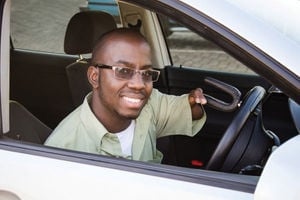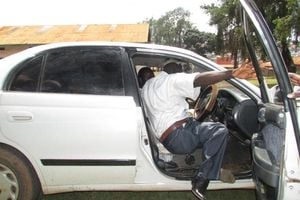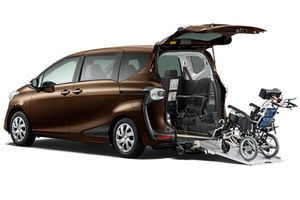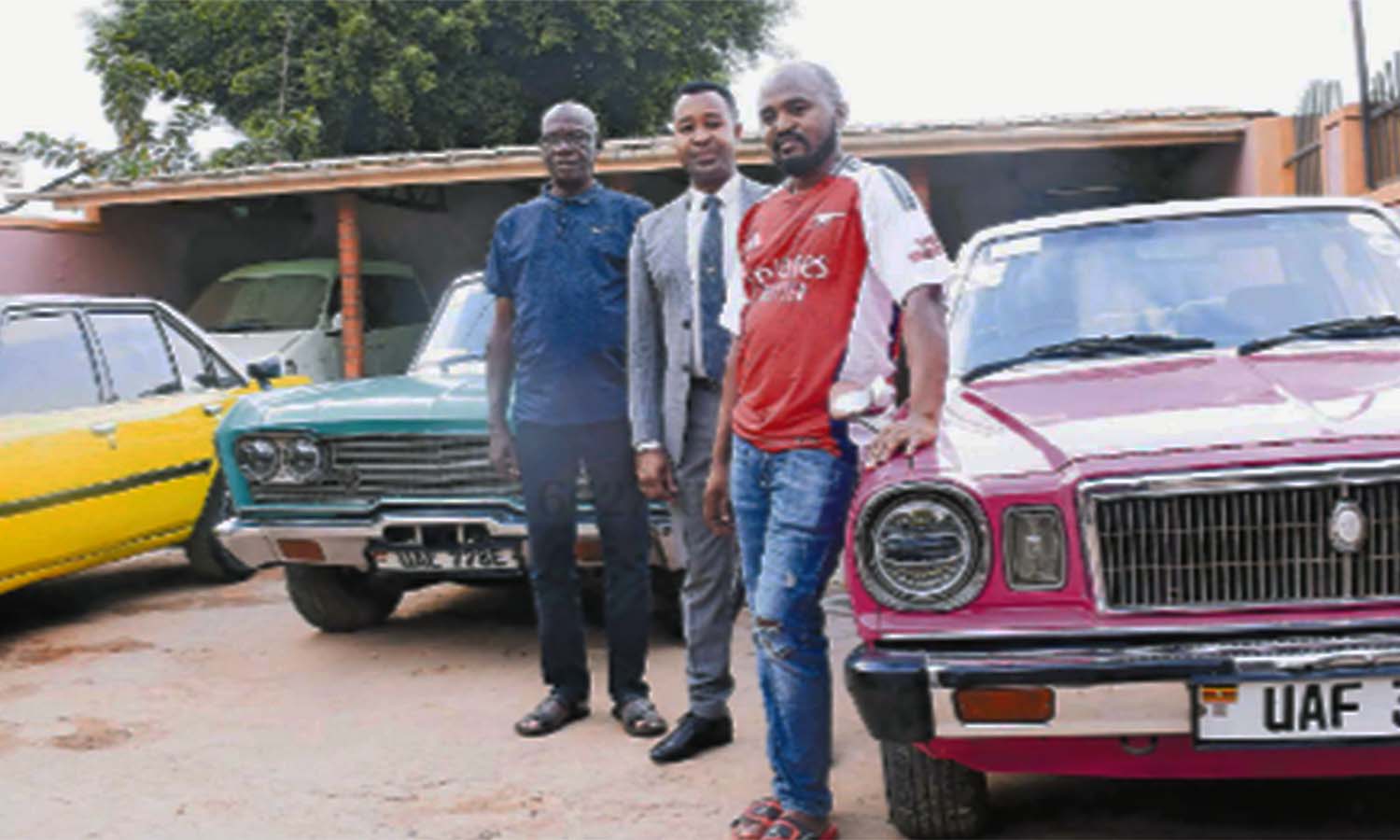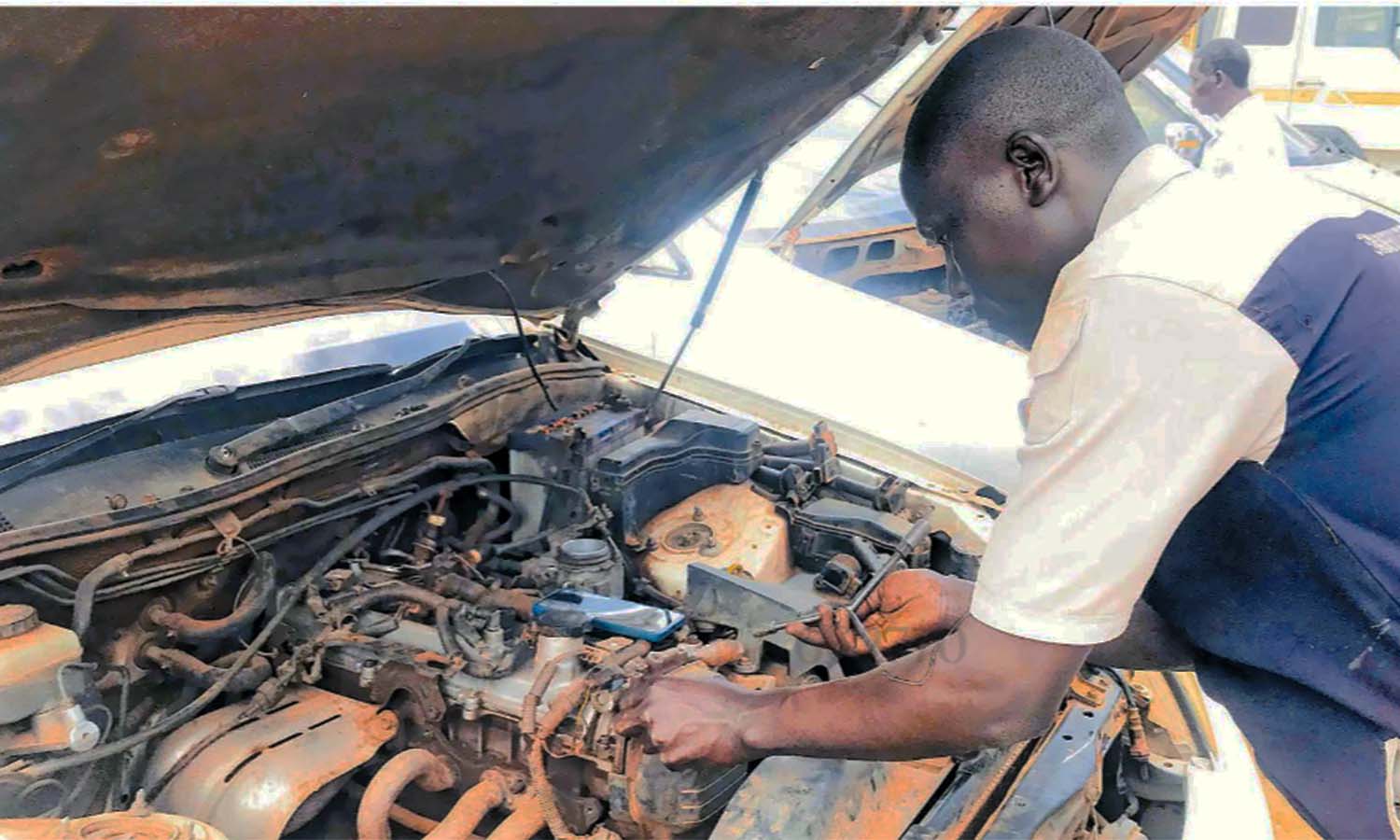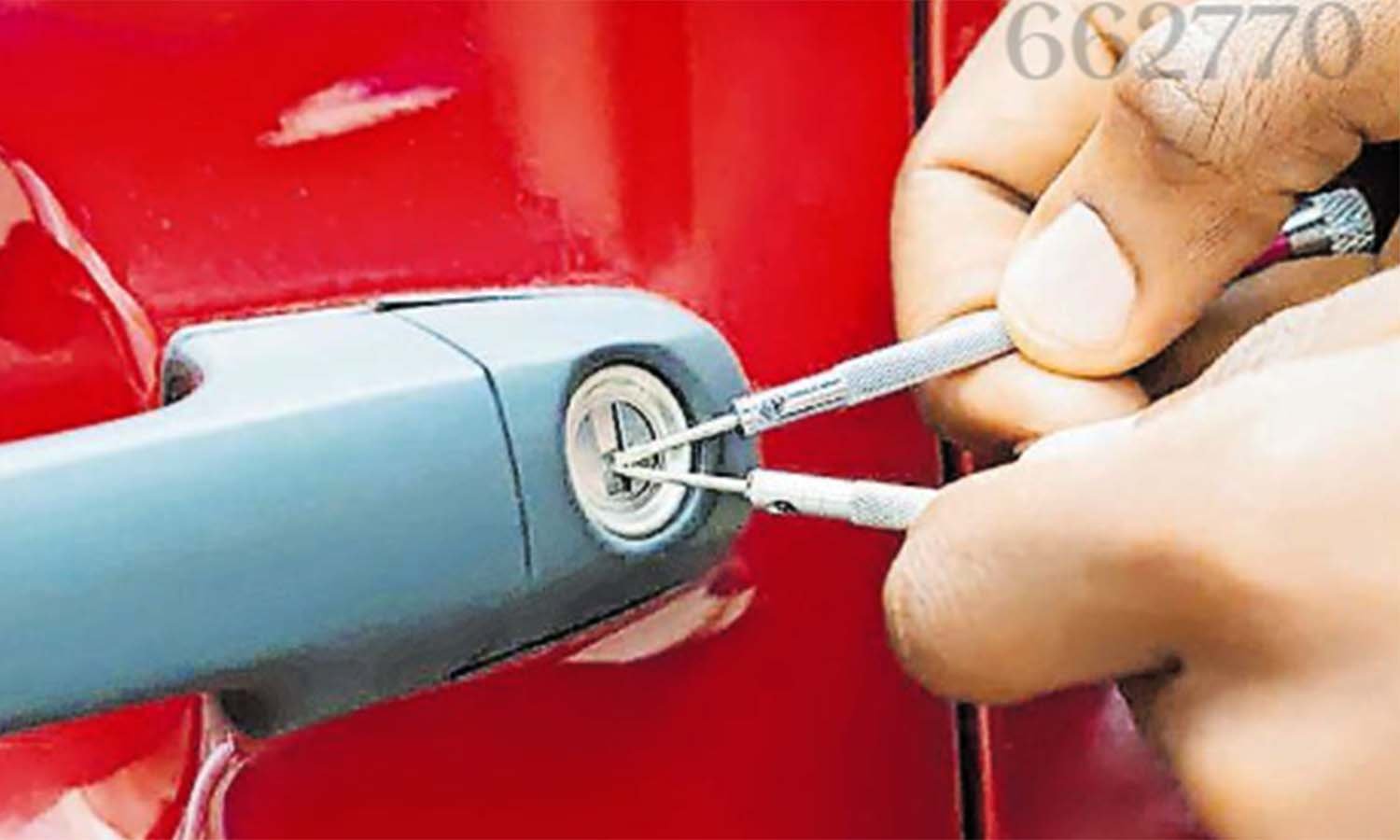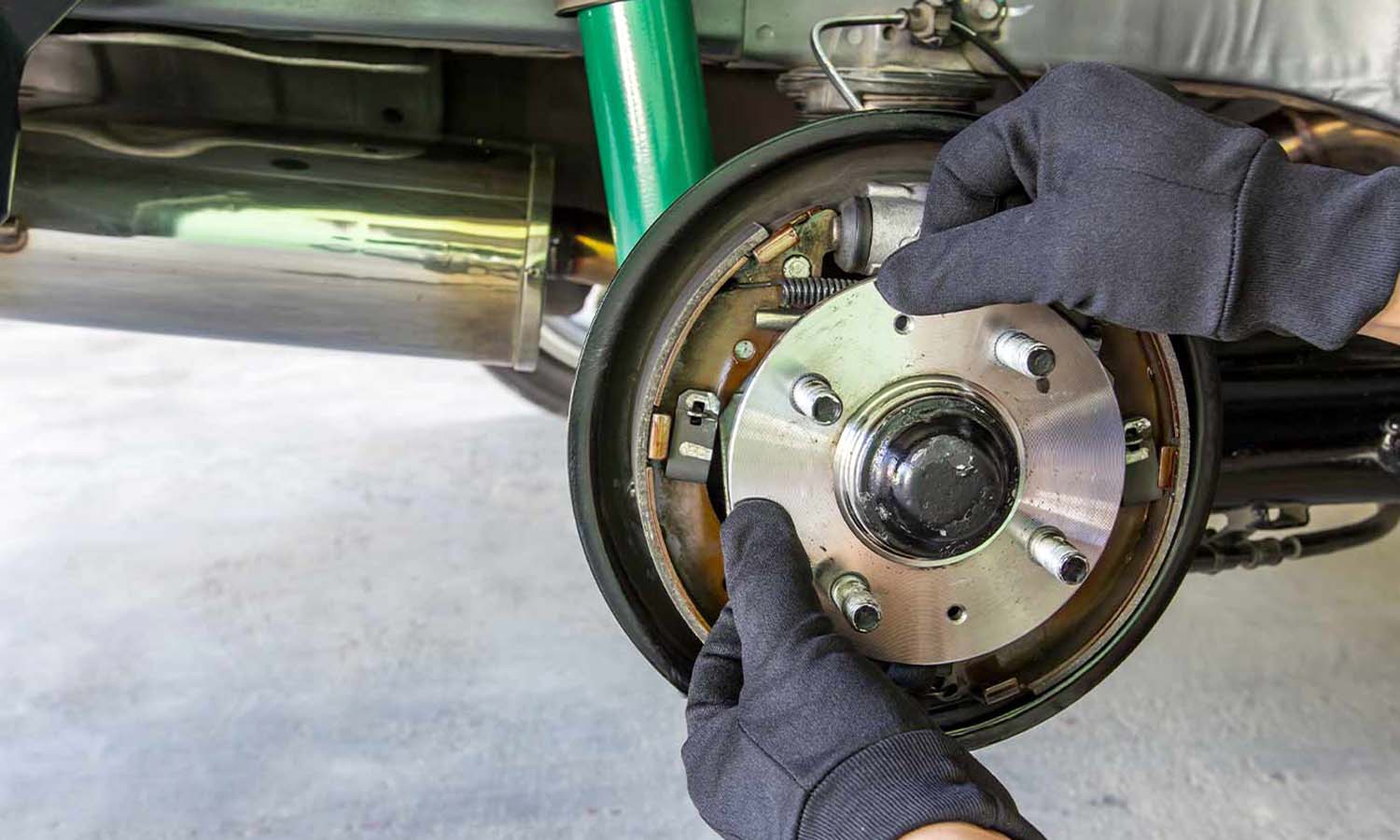
A wheelchair-accessible car operator helping a passenger enter using a ramp.PHOTOS/ABDUL-NASSER SSEMUGABI
Ronald Kalule was a jolly, playful toddler until polio paralysed his limbs when he was only three years old.
No intervention could fix his condition, doctors told his mother. And only a wheelchair could mitigate his difficulty.
“But I had never seen a wheelchair or anyone using it,”Kasule recalled. Even then, his peasant single mother could not afford one.
Mobility challenges almost denied Kasule education. The first day he tried going to school, it rained over him, soaking all his books.
“I crawled back home and told mum: I’ve given up on schooling.”
Years later,he could crawl on gravel to a nearby school, where his sister taught.
“I knew education was my only shot at redemption.”
Bright and friendly, Kasule was sometimes carried by fellow pupils to and from school, until his mother convinced ActionAid, a global charity, to get him a wheelchair.
“I got my first wheelchair when I was in Primary Five,” Kasule says. The gift also came with a transfer to Kampala School for the Physically Handicapped—a giant leap in his life. Handicap cars Decades before Kasule lost his natural mobility, Ralph Braun of Winamac, Indiana, who was diagnosed with spinal muscular atrophy and became unable to walk by the age of 15, was inventing solutions that would birth a world-renowned leading company in improving mobility.
First, Braun invented the world’s first electric scooter in 1962. Then he designed a wheelchair lift, which he installed in an old postal Jeep.
In 1972, Braun established BraunAbility, arguably the biggest dealer in wheelchair-accessible vehicles, otherwise called handicap cars, and other such life-changing mobility solutions,
partnering with major car brands such as Chrysler, Dodge, Honda, Chevrolet, and Toyota, among others.
Such vehicles are modified according to user needs and classified according to the access they provide. Driver-side access cars, for instance, are designed for physically handicapped drivers; front access cars allow handicapped passengers access the co-driver’s seat; side access cars allow handicapped passengers access any of the slots from the sides; while rear access cars allow the handicapped passenger to occupy the rear section of the vehicle from the backside. All use a ramp or a lift.
Kasule benefits from Braun’s technology whenever he travels to the US or Europe for seminars, conferences, or further studies.
“Wheelchair-accessible vehicles are more convenient than any other means of transport. But I could only use them in America or Europe,” he said.
Recently he learnt of S-Afric, a transport, logistics, and energy company that offers such services via the Kuelea Taxi, an offshoot of the Network for Medical Transportation Agencies (Nemta).
Tragedy to business
Before founding Nemta and S-Afric, Jude Tadeo Musoke injured his spinal cord following a boda-boda accident in 2021.He needed rehabilitative care during the Covid-19 lockdown when private cars and special hire services were prohibited. And ambulances were few and expensive.
He relied on a doctor friend who drove him in his car.“That’s when I realised the need for inclusive public transportation,” Musoke said.
When he got back on his feet, he joined Ambulance Africa as a marketer.
“We wanted private or public transport vehicles to have assistive technology and personnel to make the community disability-inclusive,”Musoke said.
Like Braun, the revolutionary inventor, as Musoke sought a solution, he conceived a business.
In 2022, Musoke, a member of the Disability Inclusion Network under USAID, intensified his advocacy to make people appreciate the need for an inclusive public transport system.
“A few people import handicap cars for personal use or organisations for only their people. But why not a taxi?” he always argued in conferences.
A 2016 Uganda Bureau of Statistics Census Report shows that around 4.5 million Ugandans have a disability. According to the Uganda Police traffic accident report, 16,736 people sustained
life-threatening injuries from road accidents in 2023. Musoke thinks the majority of those are left disabled, perhaps worse than him who moves on his two legs but anytime needs crutches or a wheelchair when his right leg goes numb. He said his condition will never heal.
“So how do others access rehabilitation services and reclaim their productive lives?” he wonders.
Wheelchair not enough Many Ugandans badly need "any wheelchair," like Kasule did until Primary Five. Doubtless, his first wheelchair was a huge upgrade, but not without challenges. He will never forget those days he went for holidays in Mpigi, but paid for longer journeys because Mpigi-bound taxis had no space for his wheelchair. Sometimes, he paid for three seats to accommodate his device.
Even when he upgraded to a foldable wheelchair, taxi conductors wanted him to pay for it.
Sometimes his wheelchairs needed repair. Sometimes he didn’t have someone to push him to church, or wherever.
He needed some independence.
He waited for years, until 2013 when he bought a customised Invacare electric wheelchair at £4,000 while pursuing his Master’s Degree in London. A joystick is its steering, it uses rechargeable batteries. It can also use solar. It’s heavy and steady on the ground.
“Other wheelchairs were prone to falling,” he said. It’s fast, it climbs and slopes with out external help.
Still, it’s not enough. His wheelchair cannot be accommodated in public transport means: taxis, buses, trains, and aircraft. Once, airport staff damaged its computer, which cost him a lot
to fix.
“You need to hire a car and disassemble the wheelchair, then brave the discomfort of sitting in a different chair,” Kasule said.
He needed a vehicle where he could sit in his wheelchair, comfortably. No wonder he’s the most loyal client for Musoke’s Kuelea taxi services.

Jude Musoke, the S-Afric founder, wants others to join the assisted transportation industry
‘I don’t miss my car’ When Kasule’s car got an engine problem early this year, he stopped using it until he buys a new engine. He uses S-Afric services more often. And he is not in a rush to fix his car.“I’m very comfortable in that specialised vehicle. I don’t even miss my car,” Kasule said.
“It’s even cheaper than buying fuel, servicing the car, and paying the driver.”
When Kasule needs to enter the wheelchair-accessible Toyota Sienta, its operator opens its rear and manually pulls out a metallic ramp for Kasule to propel his wheelchair into the car. The operator locks it against metallic handles which hold it firm. “Even on our bumpy roads, I feel very safe and comfortable in my wheelchair,”Kasule said.
Some clients pay their transport bills, others get offers from friends and family or donations from organisations or well-wishers. “We pray that health insurance soon considers it,”Musoke said.
Kasule finds S-Afric fees fair; almost the same as Uber, Faras, Safecar, would charge for the ordinary service. He, however, said PWDs are not a medical case, thus expressing his concern about the Sienta being branded as a medical van.
“I can’t be comfortable riding to a date in a car labelled as a medical van.”
Musoke said the branding is for promotional purposes, but admitted “it’s something we must improve, immediately.”
Importation vs fabrication Musoke lacked the capital to turn his ideas into business, until early this year when he acquired a loan to supplement his savings and bought the specialised Sienta.
He wants other car owners to join the sector though he doesn’t say how much the modified vehicle cost him. However, car dealers show that importing used Japanese handicap cars costs the same
as ordinary cars.
For instance, a 2015 Toyota Sienta, a six-seater, costs $4505 (about Shs17m) by the time it reaches Mombasa. Add taxes and the cost of carriage to Kampala, the figure might reach Shs35m.
More spacious vans cost more. A 2010 Toyota Hiace, a 10-seater, costs $8,600 (Shs32m) in Mombasa; a 2020 Toyota Noah X, a seven-seater, $10,113 (Shs37m), etc.
But if you already have your vehicle, some Uganda-based engineers can make it wheelchair accessible.
“I had never considered it but we can do it,” said Mohammad Damba, of Kanyike Skilling Centre in Nansana.
The ground support equipment engineer at Entebbe Airport said he can build a ramp that imitates the technology of car carriers.
“When the wheelchair is mounted on it, the ramp electronically slides back inside. Then the wheelchair is fastened against the car for stability,” said the man who modified a Mercedes
Benz van into a kitchen that served free food to hospitals during the Covid-19 lockdown.
Need for expansion
During the interview,the Sienta went to pick someone else. So, if Kasule got an emergency, he couldn’t access it in time.
And it only operates in Kampala and Wakiso, for six days a week. Kasule wishes the company expands its fleet and catchment area so that one enjoys the service without denying others a simi-
lar opportunity.
He also wants an assortment for different occasions. “When I’m going for a wedding I might need a Mercedes Benz,” he said. “Or if I’m going to the field in Mbale, my organisation can pay
for a car that suits the task, like a Land Rover.”
Musoke promises to address some of those concerns next year, with more vehicles and a variety of equipment.
Medical view
As Braun’s technology spread in USA and Europe, Japanese automobile giant Toyota was also developing a parallel product, later named the Toyota Welcab Series. Honda, Mazda, Nis-
san, among other Japanese carmakers, joined the wagon. Railway carriages, taxis, and buses also became wheelchair compatible.
Developed countries embraced nonemergency medical transportation for people who need assistance getting to and from medical appointments, but are not in an emergency. For example, those who can't use public or private transportation, or need more assistance than a taxi can provide.
But in Africa, except South Africa, it’s still largely an oversight. “That’s what we want to change,”Musoke said.
He imagines a mother, fresh from a Caesarean delivery. Who will drive her home safely?
What about the elderly, whose mobility declines with rising health needs?
“How do they access medical appointments and meet social obligations?” Musoke wonders.
“What about caregivers: maids, nurses, relatives? How do we make their work easier?”
Ambulances can’t be the answer to all this, he said.“How many ambulances do we have? And how many qualified personnel can operate them?”
Tax waivers
On September 25, 2008, Uganda ratified the UN Convention on the Rights of Persons with Disabilities and its option-
al protocol without reservations, meaning Uganda committed itself to accord the same rights to persons with disabilities as all other citizens.
Thus, many PWDs have acquired reasonable education but Kasule, a Master’s graduate in educational planning, economics, and international development, from the University of London, said many are not productive enough due to inaccessible environments.
That’s why Kasule started Diversity Ability Support Network System (DASUNS) to connect Ugandans with disabilities to social agencies and service providers, such as home care workers, personal aides, and sign language interpreters.
He has also appealed to organisations to have at least one wheelchair-accessible vehicle.
Kasule also tasks the government to foster the nascent yet crucial sector by offering tax waivers on specialised cars and equipment to promote social protection.
“This will make the services more available and affordable,”Kasule said.
IMPORTATION VS FABRICATION
Musoke lacked the capital to turn his ideas into business, until
early this year when he acquired a loan to supplement his savings and bought the specialised Sienta.
He wants other car owners to join the sector though he doesn’t say how much the modified vehicle cost him. However, car dealers show that importing used Japanese handicap cars costs the same as ordinary cars.
For instance, a 2015 Toyota Sienta, a six-seater, costs $4,505 (about Shs17m) by the time it reaches Mombasa. Add
taxes and the cost of carriage to Kampala, the figure might reach Shs35million.
More spacious vans cost more.
A 2010 Toyota Hiace, a 10-seater, costs $8,600 (Shs32m) in Mombasa; a 2020 Toyota Noah X, a seven-seater, $10,113 (Shss37 million), etc.
But if you already have your vehicle, some Uganda-based engineers can make it wheelchair accessible.
“I had never considered it but we can do it,” said Mohammad Damba, of Kanyike Skilling Centre in Nansana.
